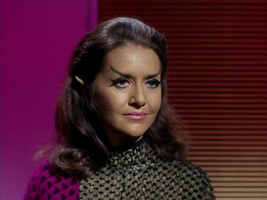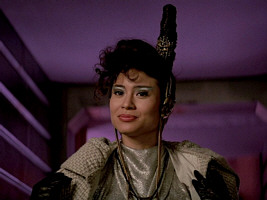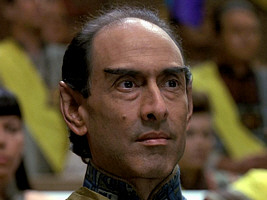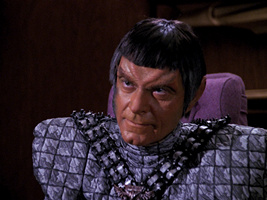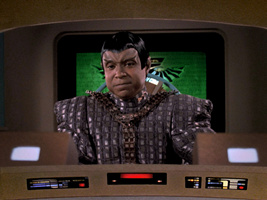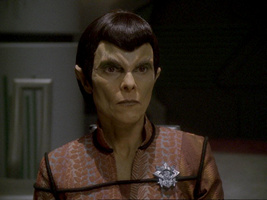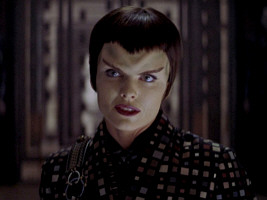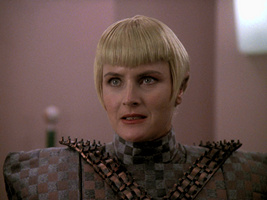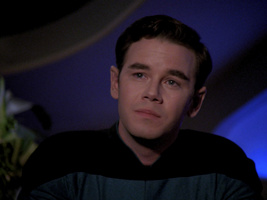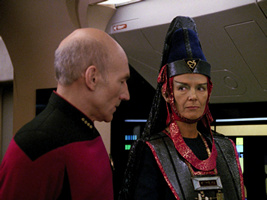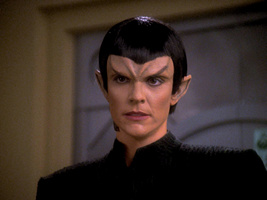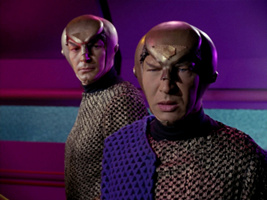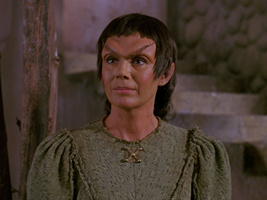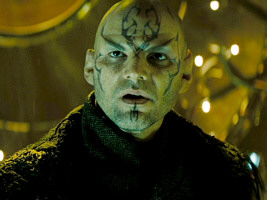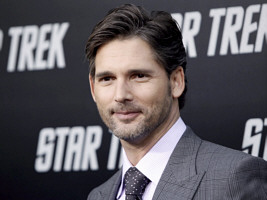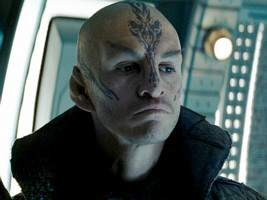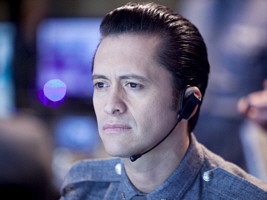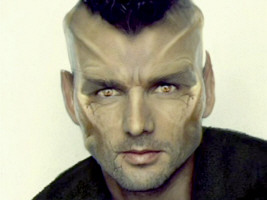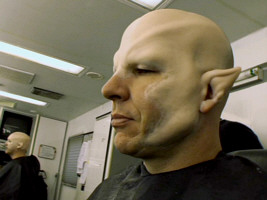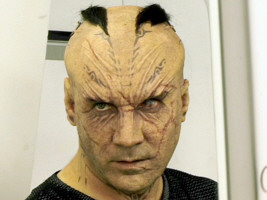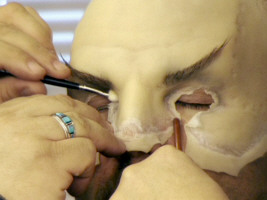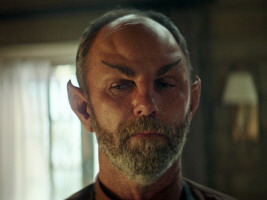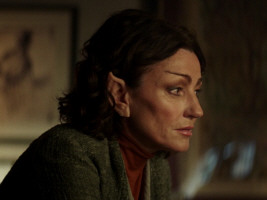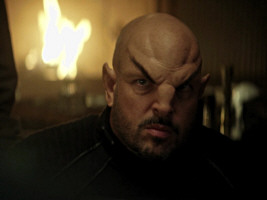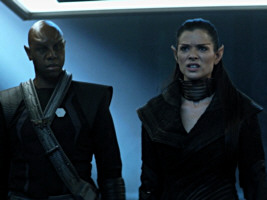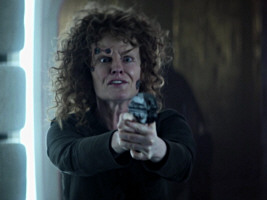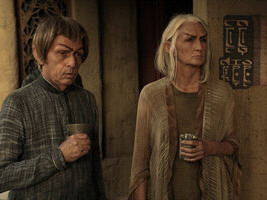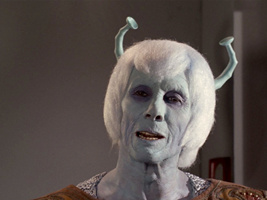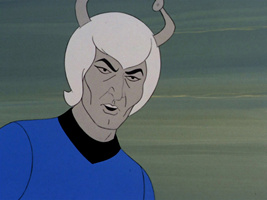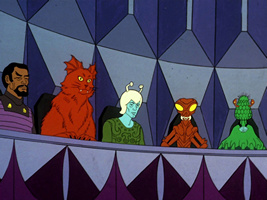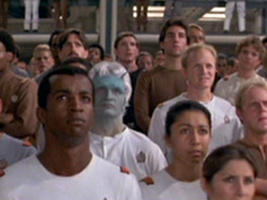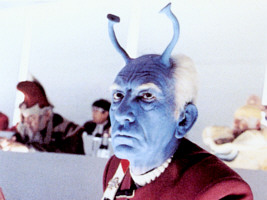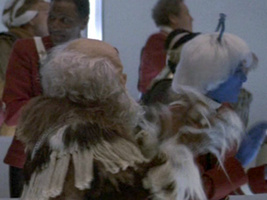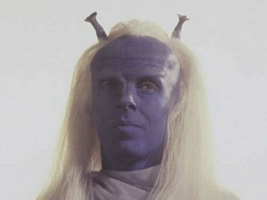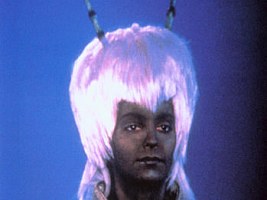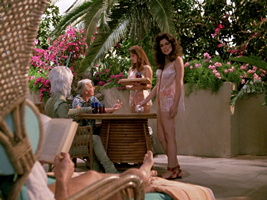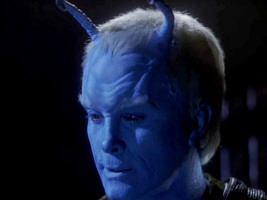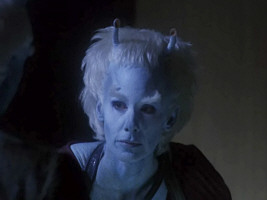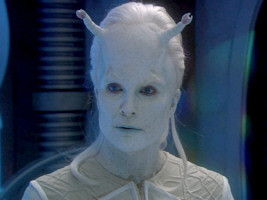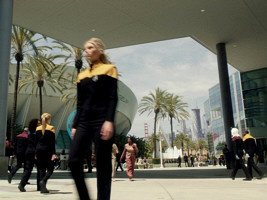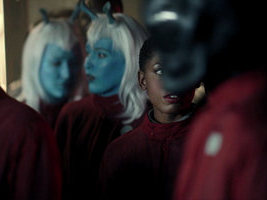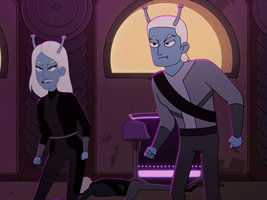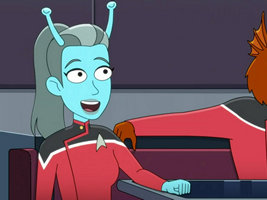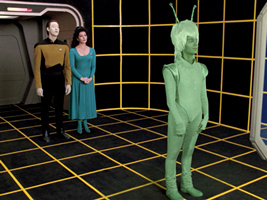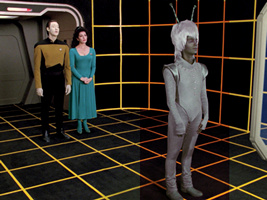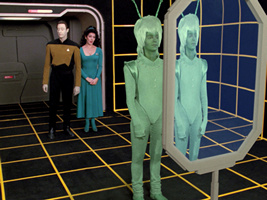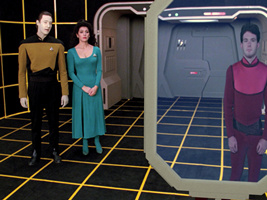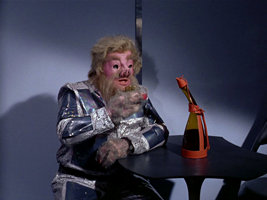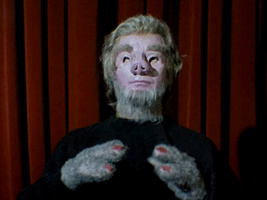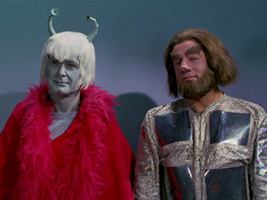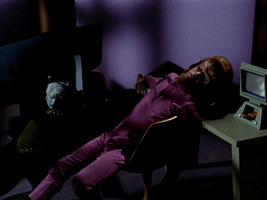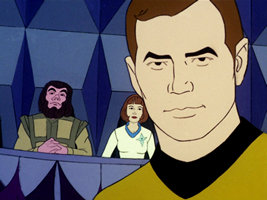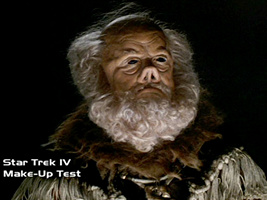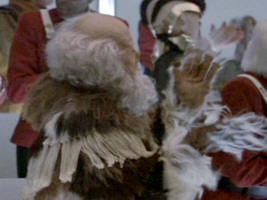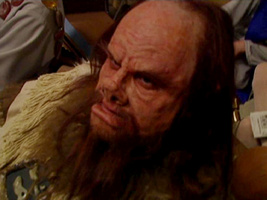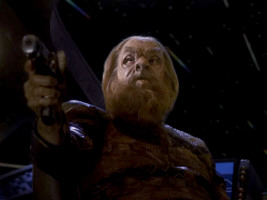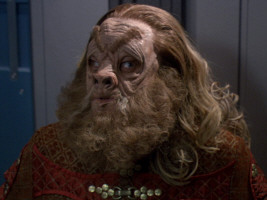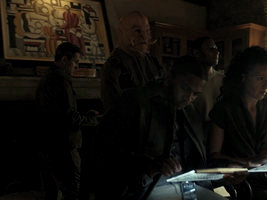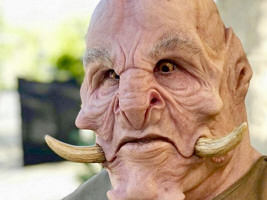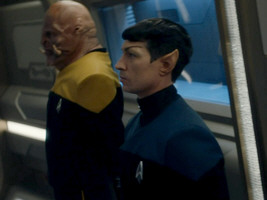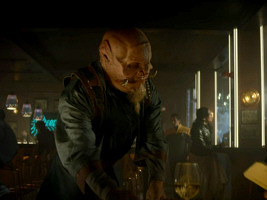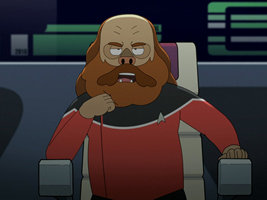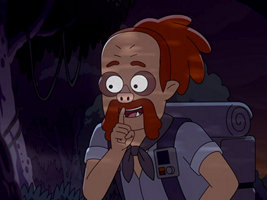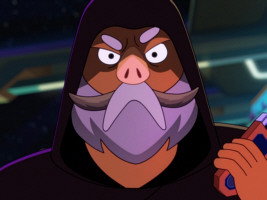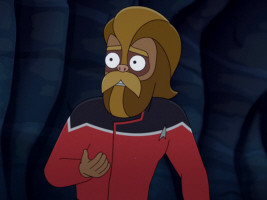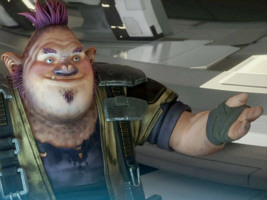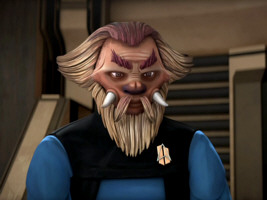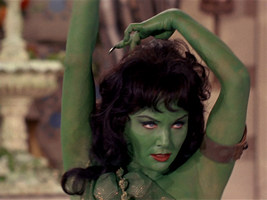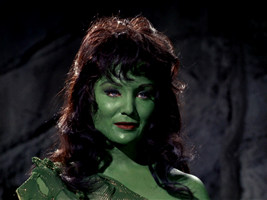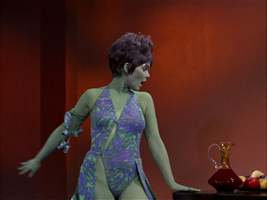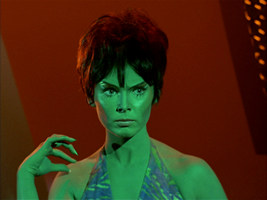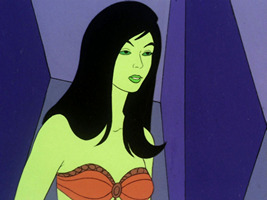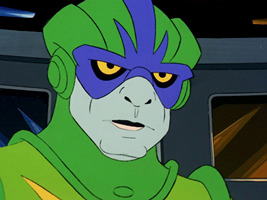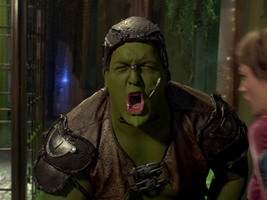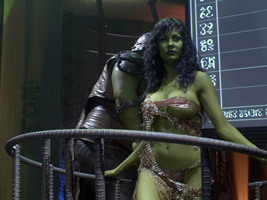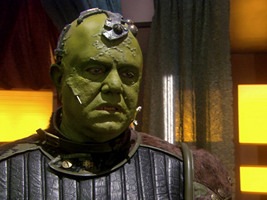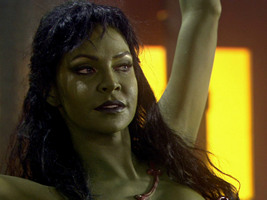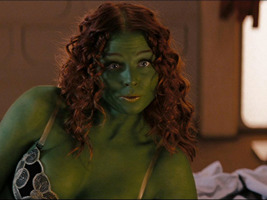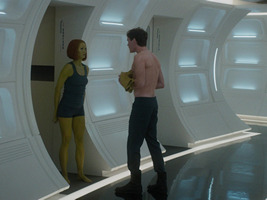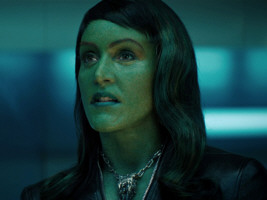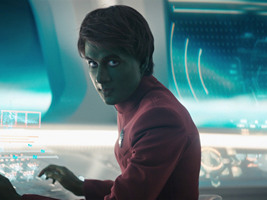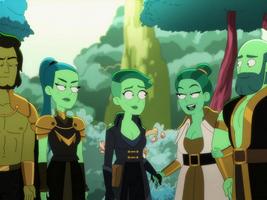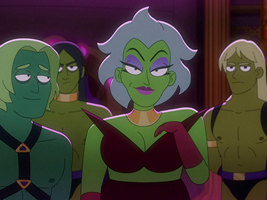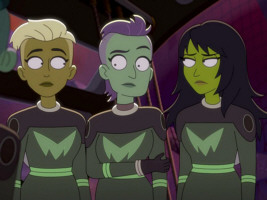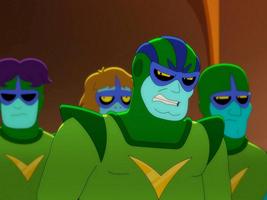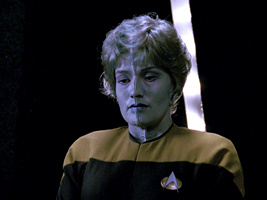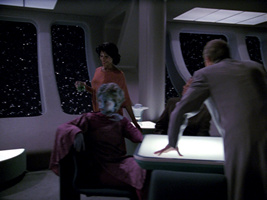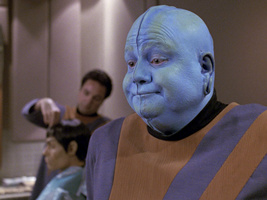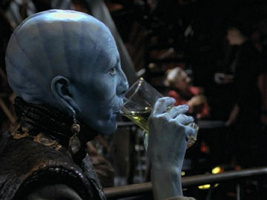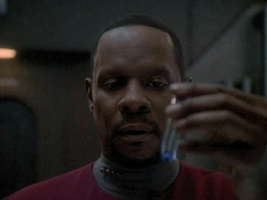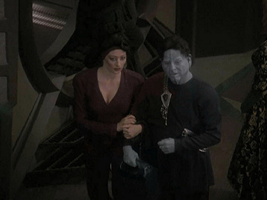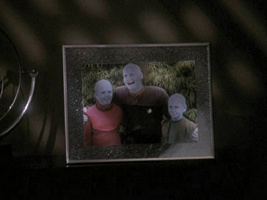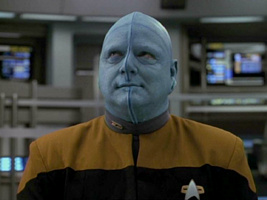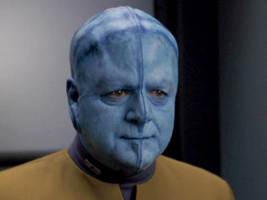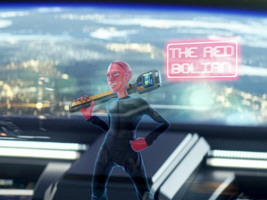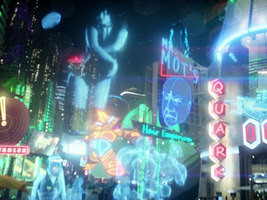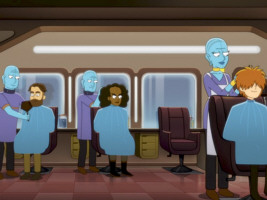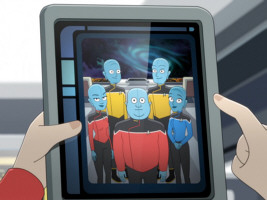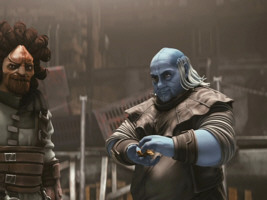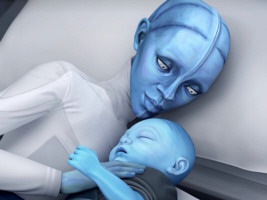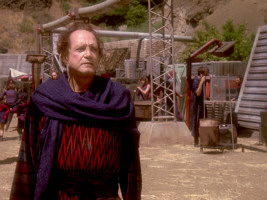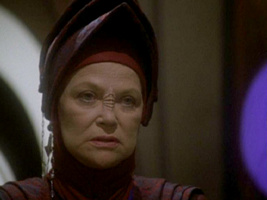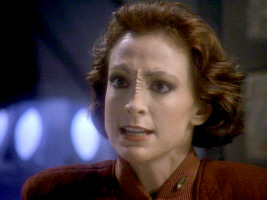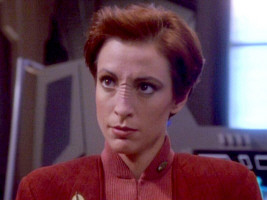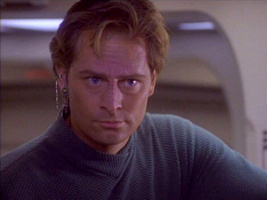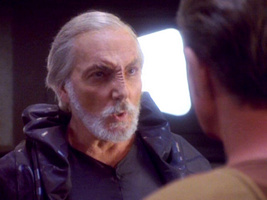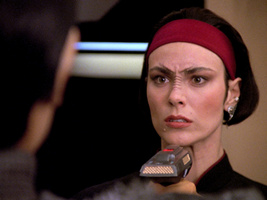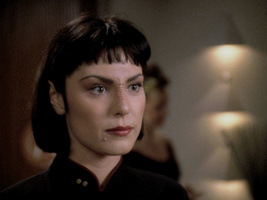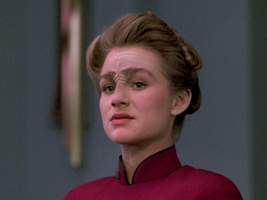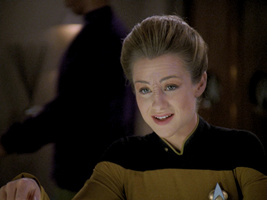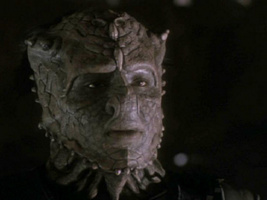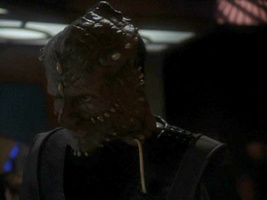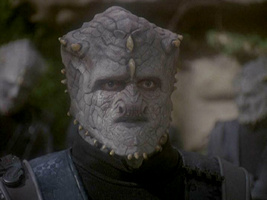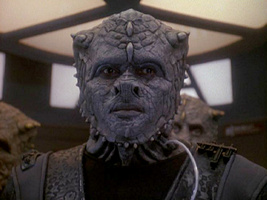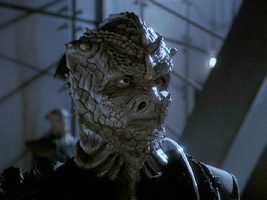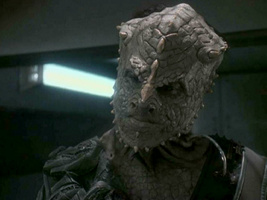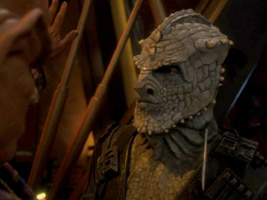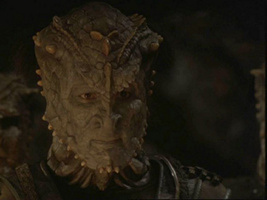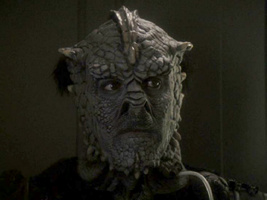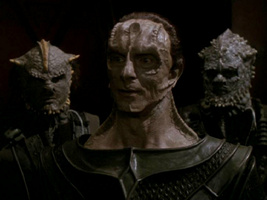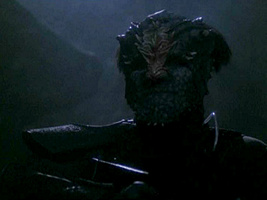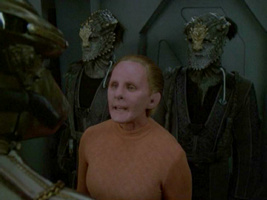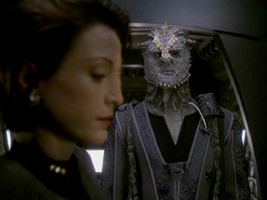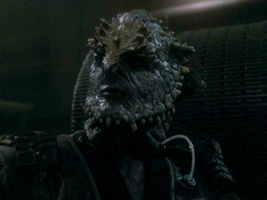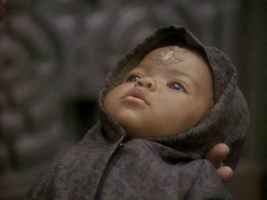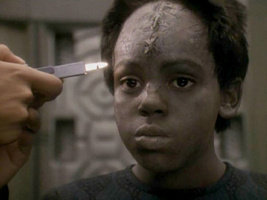Races with Changing Faces - Major Races
RomulansAndoriansTellaritesOrionsBoliansBajoransJem'Hadar
Romulans
 The redesigned Discovery Andorians and Tellarites are not discussed here. Please refer to The Visual Continuity of Star Trek.
The redesigned Discovery Andorians and Tellarites are not discussed here. Please refer to The Visual Continuity of Star Trek.The obvious motivation for the amendment of their make-up using modern techniques was that the Romulans were going to be more or less regular players in TNG. They could be given more distinctiveness this way - although the make-up department must have been aware that they are a Vulcan spin-off from a time too recent for evolution to take effect.
Although the V-shaped bones had been established in TNG, in "Star Trek V" and "Star Trek VI", filmed two years after the launch of TNG, the Romulans were given even foreheads once again. So the guise of the movie Romulans remained "consistent" with TOS. Since their alteration from TOS to TNG is not as significant as that of the Klingons and above all it was never hinted at in any TNG-era series or movie that there even was a dissimilarity, we were allowed to ignore it. Any explanation relating it to a mutation like with the Klingons would have appeared as manufactured - even if we conceded a certain likelihood that the disease that plagued the Klingons since the double feature ENT: "Affliction" and "Divergence" may have spread among the Romulans likewise.
Sela, Tasha Yar's half-Romulan daughter from a parallel timeline, looks like a Romulan without protruding cranial bones. Her haircut would conceal much but not all of the V-shaped bones like typical "purebred" Romulans have them. On a side note, her initially extremely V-shaped bang in TNG: "Redemption, Part I" is much less pronounced as soon as in the second part of the double episode and in TNG: "Unification II". Crewman Tarses from TNG: "The Drumhead", a quarter-Romulan who always passed as being three quarter human and one quarter Vulcan, even has a completely smooth forehead. Hence, we may deduce that the protruding bones are a recessive trait that would likely fade away in combinations of Romulan and alien DNA.
Romulans seem to have no trouble passing as Vulcans, or the other way round. The first case in point is T'Pel, the Vulcan dignitary from TNG: "Data's Day" who turns out to be a Romulan spy named Selak. The bones may have been surgically submerged to allow her to pose as a Vulcan. But we also get the impression that Vulcans and Romulans are still genetically identical for the most part. When Data and Beverly examine DNA traces from T'Pel's alleged transporter accident and compare them with what they believe is T'Pel's actual genome, they don't notice that the latter is Romulan. Also, Spock, even without any forehead make-up, does not strike anyone on Romulus as being a Vulcan during his underground operation in TNG: "Unification". Vice versa, there is the Vulcan terrorist T'Paal/Tallera who disguises herself as a Romulan in TNG: "Gambit". She has pronounced cranial bones like most of the Romulans. In a similar way as Selak/T'Pel she might have been surgically altered for this purpose, but the simpler explanation is that Vulcans and Romulans share the same basic traits as well as the same variations.
The Romulan Talok, who poses as a Vulcan in ENT: "Kir'Shara", has been surgically altered for that purpose though. We see him with his original Romulan forehead bones at the end of the episode. The pronounced bones might be more common among Romulans. Perhaps some of the lower-ranking Romulans in TOS who were wearing helmets actually had them too. Interestingly, some Vulcans in TOS: "Amok Time" could be seen with very similar helmets.
Speaking of uniforms, the Romulans on Enterprise (most notably in the trilogy ENT: "Babel One", "United" and "The Aenar") don't only sport the 24th century make-up but also wear the uniform style from "Star Trek Nemesis". Although there were probably financial reasons (the Romulan cityscape from "Nemesis" was reused likewise), this may add to a continuity of the Romulan look from the 22nd to the 24th century. Yet, it is hard to ignore that the Romulans were most frequently seen with the TNG/DS9 uniform style, followed by the TOS uniforms, whereas the ENT and "Nemesis" look remained more or less singular.
A fitting but not necessary rationale for the change of physiology is that the Romulans, during their long exodus, merged with other species. This would concur with the statements by McCoy from TOS: "Journey to Babel" and Chekov from TOS: "The Enterprise Incident", that Vulcan and Romulan physiology are similar yet not identical. It would also explain why none of the Vulcans on the Enterprise-D was a suited blood donor for the injured Romulan in TNG: "The Enemy" while Worf was. Yet, this does not have to mean that Klingons are possibly genetically closer related to Romulans than Vulcans are. Perhaps it is just an example corresponding with real-life transplantation medicine, where certain blood or tissue characteristics cannot be found in close relatives but sometimes in strangers. Finally, it is interesting that the Mintakans, who were described as "proto-Vulcan" in TNG: "Who Watches the Watchers", share more traits with the Romulans than with the Vulcans. But the Mintakans must have been living on their planet for much longer than the time since the Vulcan/Romulan schism. Whether they evolved from the genetic seeds of the Progenitors (TNG: "The Chase") or were relocated to the planet by the Preservers like Miramanee's people (TOS: "The Paradise Syndrome") remains uncertain.
If there are two distinct races or sub-species of Romulans, there are likely social and cultural disparities between them too, and we may come up with similar theories as they used to rationalize the existence of two Klingon races. We may explain why we see racially homogenous Romulan crews and why the Romulan Empire is so susceptive to upheavals, as Shinzon mentions in "Nemesis". Conversely, the already mentioned helmets that some low-ranking Romulans are wearing in TOS may be meant to conceal the racial difference, in order to facilitate the service of different races in the same military.
 In the first Abramsverse movie "Star Trek (2009)" all Romulans that we see are part of Nero's crew and are originally from the 24th century. They have smooth foreheads, just like the Romulans in TOS and the TOS movies, and unlike those in the 24th century series and ENT. It is very odd that none of them has the forehead bones that seem to be the predominant trait of Romulans of their time. Their bald heads and tattoos are just as uncommon. This look is explained in the non-canon comic Countdown as a mourning ritual.
In the first Abramsverse movie "Star Trek (2009)" all Romulans that we see are part of Nero's crew and are originally from the 24th century. They have smooth foreheads, just like the Romulans in TOS and the TOS movies, and unlike those in the 24th century series and ENT. It is very odd that none of them has the forehead bones that seem to be the predominant trait of Romulans of their time. Their bald heads and tattoos are just as uncommon. This look is explained in the non-canon comic Countdown as a mourning ritual.
There are, however, slight modifications to their noses that we wouldn't even notice without comparing the screen caps of Nero and Ayel with photos of actors Eric Bana and Clifton Collins, respectively. They are both wearing appliances in their roles to widen the nose and to make the bridge of the nose form more of a straight line with the forehead (coming close to the type of a Roman nose). Since this alteration is very well within the natural variations among humans, Romulans and Vulcans alike, we may easily ignore it as a distinguishing mark of Romulans.
The special features of the "Star Trek (2009)" Blu-ray show concept sketches as well as test make-ups that were done for the Romulans to appear in the movie. Besides keeping the forehead bones it was also considered at some point to create the V-shape through brandings instead. But then it was decided to remove the skin structure altogether and apply only tattoos.
Star Trek Picard shows an almost equal number of Romulans with flat and with V-shaped foreheads. The latter look is at one point, in PIC: "The End is the Beginning", referred to as that of "Northerners". Like the Zhat Vash assassin captured in that episode, Zhaban is a Northener, while Laris is not. Like Elnor, "Narissa Rizzo" and her brother Narek both have flat foreheads, whereas their aunt Ramdha is another "Northener". We can see Romulans played by black or Asian actors, or with blond or light brown hair.
Overall, Star Trek Picard establishes that the two different Romulan looks from TOS ("Southerners"?) and from TNG ("Northerners") both exist in the fictional universe, albeit without providing an explanation why previously sometimes the former and sometimes the latter wa so dominant that we saw exclusively Romulans of that one type.
Andorians
The Andorians in TOS: "Journey to Babel", "Whom Gods Destroy" and a few more episodes had intense light blue skin and antennae protruding almost straight from their heads above their ears. Obviously the make-up techniques of those days were not sufficient to show a smooth transition from the skin to the antennae, and a hair piece was ideal to conceal that imperfection.
 In TAS there are two variations of Andorians, both closely based on the TOS version. Thelin is the Andorian officer in place of Mr. Spock in "Yesteryear". His skin color is not blue at all, but a shade of yellow. Could he be an Aenar? Anyway, his antennae are the same color as his skin. In contrast, in TAS: "The Time Trap" we see an Andorian with bright teal skin and white antennae, the same color as his hair. Also, the latter Andorian looks rather crude compared to Thelin who, as a main character was visibly drawn with more attention to his features.
In TAS there are two variations of Andorians, both closely based on the TOS version. Thelin is the Andorian officer in place of Mr. Spock in "Yesteryear". His skin color is not blue at all, but a shade of yellow. Could he be an Aenar? Anyway, his antennae are the same color as his skin. In contrast, in TAS: "The Time Trap" we see an Andorian with bright teal skin and white antennae, the same color as his hair. Also, the latter Andorian looks rather crude compared to Thelin who, as a main character was visibly drawn with more attention to his features.
Make-up artist Fred Phillips reproduced only the basic Andorian look for "Star Trek I" and made a couple of changes and refinements. The antennae were now thinner and not segmented any more; they were closer together, and there may have been slight forehead ridges. The hair color of the TMP aliens appeared to be yellowish or blond on photos (like in The Art of Star Trek) but was rather white like that of TOS Andorians on screen. The appearance did not remain quite consistent through the movies. In "Star Trek IV" there was one bald Andorian whose antennae were attached to an otherwise even forehead and thicker again. Another member of his race in the same movie looked again more like in TOS, as did the Andorian god who could be seen in "Star Trek V", the latter possibly with an enlarged forehead.
The look of Andorians most noticeably changed in TNG: "The Offspring" where one of Lal's choices of appearance presented on the holodeck was an Andorian female. A photo from The Art of Star Trek of this Andorian make-up exhibits a considerably darker and much less bluish skin, although it is greenish in the episode itself as will be analyzed a few paragraphs later. Also, the antennae were ribbed like twigs instead of smooth. A similar Andorian appeared on Risa in TNG: "Captain's Holiday" but was only seen from behind, barely giving away his or her skin color.
Enterprise re-introduced the Andorians with ENT: "The Andorian Incident". Their look can be described as a middle ground between TOS and Movie style. The Andorians now have clearly visible protruding bones in their foreheads as the bases of their antennae. The antennae are also in motion, but this is something we simply may not have seen Andorians do before.
We may conclude that Andorians always had moving antennae. Some of them (a distinct race/subspecies?) have an either brown or green skin (in any case nothing like blue), as well as differently shaped antennae. Also, all of them arguably have protruding bones, we only couldn't see them when they were covered with hair. The only exception would be the bald Andorian in "Star Trek IV", but he wasn't clearly visible anyway. Unfortunately none of the various Andorian variants is remotely similar to the subspecies of the Aenar with their characteristic pale skin and eyes (ENT: "The Aenar"). Making the Aenar look more like the Andorian woman from TNG: "The Offspring" would have been an opportunity to create better consistency. Still, the existence of the Aenar (who may still have no role in the Andorian society in the 23rd and 24th century, which would explain their absence from TOS and TNG) makes it more plausible that there are other distinct subtypes of Andorians as well.
Star Trek Picard shows Andorians in PIC: "Remembrance" (in the background in front of the Starfleet Quantum Archives) and in PIC: "Maps and Legends" (one near Starfleet Headquarters, as well as two clearly visible young women on the Artifact). All of them are classic Andorians, as opposed to the Discovery re-imagination. The simplistic make-up in PIC, with the wig that covers the bases of the antennae and the intense turquoise/blue skin color, is closer to that of TOS and the TOS movies than the one created for Enterprise. On the other hand, even Discovery had background performers with the classic Andorian make-up, probably to save costs.
 All Andorians of Lower Decks are classic ones, with an antenna placement as in the movies and more recently in ENT. None of them has forehead ridges, however. We might argue that particular feature was so slight in ENT that it would rather be omitted from the animated version. We can also notice that there are two different hues. In "Envoys", we can see all-blue Andorians, whereas Ensign Jennifer is more like turquoise, just as the Andorians who most recently appeared in Star Trek Picard's season 1.
All Andorians of Lower Decks are classic ones, with an antenna placement as in the movies and more recently in ENT. None of them has forehead ridges, however. We might argue that particular feature was so slight in ENT that it would rather be omitted from the animated version. We can also notice that there are two different hues. In "Envoys", we can see all-blue Andorians, whereas Ensign Jennifer is more like turquoise, just as the Andorians who most recently appeared in Star Trek Picard's season 1.
The green "Offspring" Andorian
As already hinted at, Data's "daughter" Lal poses as an Andorian female in TNG: "The Offspring". However, as opposed to the dark brown skin on the photograph, the actual screen cap from the episode shows us a greenish face. But it's not just the face. Her whole body has a greenish hue, including her hair and the originally silver shoulder pads of her uniform. Also, the contrast of her body is lower than that of the surrounding as if she were standing in a bright green spotlight that were completely absorbed by everything else in the room. All this insinuates that the scene has been tampered with. The question is if this Andorian is really supposed to be green or if we can ascribe the strange color to the lighting conditions nonetheless, or to some other effect of the holodeck.
As to whether the green filter effect was intentional, we need to review the whole scene and the episode's screenplay. In an image editor, it is easy to decrease the green portion of the RGB screen cap and to restore the probably original look of the Andorian just like on the photo. It also becomes clear that only the Andorian figure was manipulated, not the yellow grid lines of the holodeck, which are way too dark after the color and contrast correction. The same goes for Data and Troi, who are located behind Lal and who appear in normal colors. Lal is standing in front of some sort of semi-transparent mirror, which may throw green light on just her body (at least that's what we may be supposed to think; the light evidently doesn't come from there). On the other hand, Lal herself poses as three other lifeforms, none of whom appears in false colors: a male human, a female human (her final choice), a Klingon and the original silver android look. All these creations are bluish when seen through the mirror but in natural colors in an unobstructed view.
The excerpt from the script with the writer's notes, describing the set as Data and Troi walk in, confirms that the bluish glass pane is actually meant to be a mirror:
9A ANGLE (OPTICAL)
to see Data has created a modest set with a mirror... in front of which stands Lal...
Data: "Computer, Lal -- gender sequence finalists... begin..."
Superimposing with a wipe (necessary I think to distinguish that she is not actually changing into these beings)...9B AN ANDORIAN FEMALE (OPTICAL)
Data: "An Andorian female..."
Considering that all of Lal's choices are just holographic images ("she is not actually changing into these beings"), they are not subject to lighting conditions and anything is possible anyway. Lal may have chosen to tone down the Andorian figure for some reason, or it may be a glitch in the holodeck software that she appears in bright green instead of brown. Regarding the mirror, it may be transparent and blue just because it looks more sophisticated this way and to allow the camera to pan half-way around Lal. Still, this doesn't explain why the Andorian is green in the first place, even without looking through the glass.
The real-life rationale for Lal's changing look may be as follows: It is evident that the different holographic versions of Lal were all retroactively inserted into the holodeck scene with Troi and Data. This additional effort was necessary to allow the transition effects between them. In the early 1990s, the most common method of image composition was the blue screen technique (no, not the one invented by Bill Gates ;-)). However, filming a blue Andorian against a blue wall may have resulted in parts of the face being cut out like the blue background. It is only a theory, but this may be the reason why it was decided to change the Andorian face to brown in the first place. When completing the scene, the visual effects artist may have tried to tone down the perhaps too harsh contrast of white hair and dark skin. With blue being too unnatural, the Andorian woman was digitally manipulated to the green version as it appeared in the episode.
Tellarites
It may be surprising that Tellarite appearances can be confirmed for no more than two TOS episodes: "Journey to Babel" and "Whom Gods Destroy". In addition, two more different Tellarites can be seen out of the episode context in the end credits of TOS: "A Private Little War" and "The Deadly Years", respectively. The latter look like they could have originally been test shots for the characters who would appear in "Journey to Babel". Finally, after the attack of the non-corporeal Zetarians on Memory Alpha we can see a dead alien in a chair next to his Andorian colleague. He very likely is intended to be another Tellarite although his make-up looks a bit different. All these versions of Tellarites have a make-up with a "swinish snout" in common, but aside from that there is some variety already during the three years of TOS.
On the first appearance of Tellarites in "Journey to Babel" Ambassador Gav and his unnamed aide are characterized by their recessed eyes and furry claws with three fingers. The look of the two aforementioned Tellarites from the end credits is much the same, which, in addition to their posture, speaks in favor of the theory that these are test shots made prior to "Journey to Babel". The Tellarite in "Whom Gods Destroy" has the same claws, but his eyeholes are not deepened; they look more like those of humans. The alien in "The Lights of Zetar", on the other hand, has five fingers instead of the claws, and his eyeholes are human-like. Aside from his furry eyebrows the latter could easily be a human being or a member of another of the many human-like TOS races, just with a big nose.
 In TAS: "The Time Trap" there is a Tellarite among the members of the Elysian Council with only slightly recessed eyes and (most likely) five fingers.
In TAS: "The Time Trap" there is a Tellarite among the members of the Elysian Council with only slightly recessed eyes and (most likely) five fingers.
Tellarites also show up in the movies "Star Trek IV" and "Star Trek VI". The screen caps of the two movies are taken from the DVD bonus material. While the very two depicted Tellarites can be seen in the respective movies, they are too far in the background to recognize any details. In "Star Trek IV" the Tellarite make-up is a faithful further development of the look established in TOS: "Journey to Babel", including the deep eyeholes. The nose is still largely identical to the one from TOS, only a bit more rounded, which tones down the impression of a pig snout. The Tellarite in "Star Trek VI" has the same kind of a more rounded nose, but his eyeholes are human once again. In "Star Trek IV" we can see the Tellarite's hands, and while they look clumsier than human hands, there are five fingers.
The make-up established in Enterprise (first seen in "Bounty") maintains the basic look of the Tellarite faces with a nose, which is modified once again to look a bit less swinish. The Enterprise Tellarites have recessed eyes again and five fingers. Regarding their noses and other details, so far the repeated make-up revisions are small enough to neglect them and attribute them to better make-up techniques. Also, the Tellarite species could well have a certain racial variety. However, there is no simple explanation along the lines that there may be two sub-species with different numbers of fingers, considering how important this characteristic would have been in the course of their evolution, which would have given the five-fingered Tellarites a decisive advantage. Maybe one of the two versions (preferably the rather rare three-fingered TOS Tellarite) is actually a mutation, or some of the TOS Tellarites are wearing strange furry gloves?
One member of the FNN team in PIC: "Remembrance" is meant to be a Tellarite per social media posts and looks a bit like the Discovery-style reimagination of the species (that is not discussed in this article). Aside from the tusks a classic Tellarite shouldn't have and the differently shaped eye holes, the guy in "Remembrance" is also the first beardless male Tellarite ever seen on Star Trek. But as we look closer, he is still different than any variation seen so far and is the most extreme reimagination of the species ever, by a wide margin. Besides his anvil-shaped chin (that we arguably couldn't see on the so far always male and always bearded members of the species), he has a much clunkier and more voluminous head, ears that are almost flush with the skull and a completely new nose that is still less swinish than on the Tellarites we saw on DIS. The peculiar make-up is re-used several times in the third season, for different members of the species, some of whom have a goatee.
It remains a mystery why the Art Department of Picard created a totally new proprietary variation of Tellarites that is being used repeatedly and exclusively on the show, leaving no other interpretation than the one that all Tellarites are meant to look like that (aka "visual reboot"). But the radical deviation from canon allows the question whether all these folks shouldn't rather be another, so far unknown race.
 Lower Decks only shows classic Tellarites with eyeholes, much like those from TOS or ENT. Owing to the simplifications of the animation, their faces could represent both of the slightly different classic live-action versions of the race. The LOW Tellarites all have five fingers, just as the ENT version. Only one of them, the guy on Starbase 25 in LOW: "An Embarrassment of Dooplers", sports tusks (or a beard shaped to look like a tusk?).
Lower Decks only shows classic Tellarites with eyeholes, much like those from TOS or ENT. Owing to the simplifications of the animation, their faces could represent both of the slightly different classic live-action versions of the race. The LOW Tellarites all have five fingers, just as the ENT version. Only one of them, the guy on Starbase 25 in LOW: "An Embarrassment of Dooplers", sports tusks (or a beard shaped to look like a tusk?).
 Even if we consider the different animation style than in Lower Decks, Jankom Pog doesn't look at all like any of the Tellarites in classic Star Trek, but not like the revisionist designs from Discovery or Picard either. The nose is less swinish, and he notably has a spotted skin. His youth may not explain some of the many differences. A Tellarite named Dr. Noum belongs to Admiral Janeway's crew, who has more facial hair but shares the shape of the nose and the skin pigmentation with Pog. The adult Tellarite also has tusks. Another interesting observation is that Pog is the first three-fingered member of his species since TOS, whereas Dr. Noum has five fingers.
Even if we consider the different animation style than in Lower Decks, Jankom Pog doesn't look at all like any of the Tellarites in classic Star Trek, but not like the revisionist designs from Discovery or Picard either. The nose is less swinish, and he notably has a spotted skin. His youth may not explain some of the many differences. A Tellarite named Dr. Noum belongs to Admiral Janeway's crew, who has more facial hair but shares the shape of the nose and the skin pigmentation with Pog. The adult Tellarite also has tusks. Another interesting observation is that Pog is the first three-fingered member of his species since TOS, whereas Dr. Noum has five fingers.
Orions
Orions appear in some form three times on TOS. Vina as an Orion slave girl in "The Cage" (and in "The Menagerie II") is just an illusion created by the Talosians but is at least meant to look authentic. The Orion disguised as an Andorian in TOS: "Journey to Babel" is never fully reverted to his actual appearance. The only true Orion to appear in the series is Marta in TOS: "Whom Gods Destroy". Both Orion women of the series have dark hair; the make-up is pale green. Marta seems to be even paler than Vina, although when she is dancing and on random other occasions in the episode a green spotlight is directed at her.
 We can see Orions on two occasions in TAS. The first time is in TAS: "The Time Trap". Here, an Orion woman named Devna is a member of the Elysian Council. Her appearance is in line with Vina and Marta, although her skin color is a lighter, more yellowish shade of green. Orions appear one more time on TAS, in the episode "The Pirates of Orion". For some reason, they are pronounced "Or-ee-ons" on this one occasion, instead of "Or-I-ons". Also, their skin is blue, rather than green. The reason for the latter is not clear; the color change, just like the mispronunciation, may not have been introduced on purpose.
We can see Orions on two occasions in TAS. The first time is in TAS: "The Time Trap". Here, an Orion woman named Devna is a member of the Elysian Council. Her appearance is in line with Vina and Marta, although her skin color is a lighter, more yellowish shade of green. Orions appear one more time on TAS, in the episode "The Pirates of Orion". For some reason, they are pronounced "Or-ee-ons" on this one occasion, instead of "Or-I-ons". Also, their skin is blue, rather than green. The reason for the latter is not clear; the color change, just like the mispronunciation, may not have been introduced on purpose.
Orions vanish from the franchise until 2004. Not a single member of the species shows up in TNG, DS9 or Voyager. The reason may be that the Orion slave women or dancers were seen as a sexist relic of the 1960's. The Orion Syndicate, on the other hand, is repeatedly referred to and members of this criminal organization are shown (notably in DS9: "Honor Among Thieves"), but none of them is actually an Orion. At the time the Syndicate was conceived, it may not have been intended to be related to the species but to the constellation of the same name (which has a significance only in a geocentric view of the universe).
Orions reappear as late as in season 4 of Star Trek Enterprise. In "Borderland" and "Bound", we can see various Orion women (all slave girls) and men (all slavers). The skin color is a more intense and more yellowish shade of green than in TOS. It is possible that extra green light was used in some takes, albeit not as blatantly as in TOS: "Whom Gods Destroy". All women have dark hair just as on previous occasions. The heads of real Orion men are fully visible for the first time in the franchise, and all of them are bald. The outcome of "Bound" is that the Orion women control the men with their pheromones, rather than really being slaves. This really doesn't make sense in the big picture and remains an isolated note for a long time.
 All three Kelvin Timeline films show Orions in some fashion. Most notably young Kirk has an affair with an Orion girl named Gaila in "Star Trek (2009)". Gaila has red hair, as opposed to the Orions seen so far. The make-up appears to be about the same color as previously on Enterprise. In a deleted scene, Kirk runs into an Orion woman on the Enterprise and mistakes her for Gaila. She too has red hair, which may also be the reason for his mistake. Two Orion females can be briefly seen in the other two movies, and they both have red hair as well, which so far is a peculiarity of the Kelvin Timeline.
All three Kelvin Timeline films show Orions in some fashion. Most notably young Kirk has an affair with an Orion girl named Gaila in "Star Trek (2009)". Gaila has red hair, as opposed to the Orions seen so far. The make-up appears to be about the same color as previously on Enterprise. In a deleted scene, Kirk runs into an Orion woman on the Enterprise and mistakes her for Gaila. She too has red hair, which may also be the reason for his mistake. Two Orion females can be briefly seen in the other two movies, and they both have red hair as well, which so far is a peculiarity of the Kelvin Timeline.
 This article otherwise disregards Discovery, as the series used to reboot species for the sake of rebooting them. But the developments of Orions shouldn't remain unmentioned because they still play a role. Discovery begins to show members of the species with different skin colors (such as very light in "Will You Take My Hand?") and occasionally with red hair. SNW shows Orions in "The Serene Squall" and in "Those Old Scientists", who are pirates (as in TAS: "The Pirates of Orion"), rather than slavers (as in TOS and ENT).
This article otherwise disregards Discovery, as the series used to reboot species for the sake of rebooting them. But the developments of Orions shouldn't remain unmentioned because they still play a role. Discovery begins to show members of the species with different skin colors (such as very light in "Will You Take My Hand?") and occasionally with red hair. SNW shows Orions in "The Serene Squall" and in "Those Old Scientists", who are pirates (as in TAS: "The Pirates of Orion"), rather than slavers (as in TOS and ENT).
Star Trek Picard shows Orions on a few occasions in the third season, but no notable characters and never with good lighting. All of them are green, all have dark hair except the drug dealer in PIC: "The Next Generation", who is bald.
 The by far highest number Orions in the franchise appear in Lower Decks, including D'Vana Tendi as a regular character and her family. D'Vana and her sister D'Erika are about the same green as in TOS. But we can see many different shades of green in the Orion-centered episodes of the series, such as "Something Borrowed, Something Green" and "Shades of Green". Notably, every member of the Tendis' crew is a different green (the girl who wants to become a dancer being very much like those in ENT season 4). So the series, like already Discovery, attempts to reconcile the various different Orions by passing it as diversity within the species, rather than as make-up changes.
The by far highest number Orions in the franchise appear in Lower Decks, including D'Vana Tendi as a regular character and her family. D'Vana and her sister D'Erika are about the same green as in TOS. But we can see many different shades of green in the Orion-centered episodes of the series, such as "Something Borrowed, Something Green" and "Shades of Green". Notably, every member of the Tendis' crew is a different green (the girl who wants to become a dancer being very much like those in ENT season 4). So the series, like already Discovery, attempts to reconcile the various different Orions by passing it as diversity within the species, rather than as make-up changes.
Something else of note regarding the Orions happens in Lower Decks. The ambiguity about the slavery introduced in ENT: "Bound" may have been the reason why modern Trek so far focuses on the pirate aspect. We can repeatedly see Orions in that role in DIS, SNW and LOW, with nothing hinting at either a patriarchy or a matriarchy. LOW: "Something Borrowed, Something Green" tries to bring the two stories together again. Mariner explicitly mentions the pheromones of the "Orion showgirls" (in "Bound") and insinuates they were made up by Starfleet to save a captain's (Archer's) reputation - only to be proven wrong by how the planet presents itself. Women are in charge everywhere on Orion.
Regarding the look of the Orions, Lower Decks eventually also reconciles the blue Orions from TAS: "The Pirates of Orion" with the rest of Trek. As seen in LOW: "Dos Cerritos", the Blue Orions are just another skin type. The episode even confirms the pronunciation as "Or-ee-ons" (which is the accent they speak) and lampshades the silliness of their costumes.
Bolians
The Bolian look was subject to a number of amendments from early TNG to Voyager. As it is with the Andorians too, we may ultimately explain away refinements of the make-up. But above all the question whether Bolians are generally bald still needs to be answered. The first Bolian to appear on screen is Captain Rixx in TNG: "Conspiracy". His make-up is much fainter blue than that of later Bolians; in the dim lighting inside the asteroid one can hardly see that he is blue at all. Note that the rift on his head is not running down his entire face. It is interrupted above the eyes and between mouth and chin. This is different with Mitena Haro's make-up in TNG: "Allegiance". Not only is the rift more pronounced, she also has hair. Like Picard, Mitena Haro is kidnapped by unidentified aliens. In her case it doesn't matter that she is only a fake Bolian, since Picard should easily unmask her if all Bolians were hairless by nature. Thus, at the time of the episode all female Bolians may have been supposed to have hair - or they all wear wigs. Actually, in TNG: "Ménage ā Troi" we see a second Bolian woman with hair sitting in Ten Forward.
A Bolian hairdresser has an appearance in TNG: "Data's Day" and once again in "Ensign Ro". The second one is played by a different actor and is addressed as Mr. Mot, whereas the first one is named V'Sal in the script, so they are really meant to be two different people. The fact that Bolians choose to become hairdressers was apparently meant as an ironical prank, although it was never stated that all Bolians all bald. It is also remarkable that Mr. Mot has a make-up much like the first one, and unlike the DS9 Bolians, whose look was introduced in TNG: "Birthright", prior to "Ensign Ro".
The bridge officer on the Saratoga in the DS9 pilot episode "Emissary" still has the same look as the TNG Bolians. The Bolian make-up was revised a few episodes later and the colors are consistent hence. It is now a more intensive blue, and darker blue stripes run across the head between the ears. Since their blood is blue as shown in DS9: "The Adversary", we can infer that these are arteries running directly underneath the skin. It is remarkable that all female Bolians on DS9 and Voyager, including the TNG episode "Birthright", are hairless. The same is true for children. We have evidence in the form of a family photo from DS9: "Field of Fire" with bald Bolian children. There is even better evidence that at least all male Bolians are bald. In DS9: "The Muse" Jake Sisko spots a Bolian with hair on the promenade deck and concludes he is trying to impress a dabo girl with his toupee. The toupee looks really bad, but how can Jake be sure about that and find it noteworthy if not Bolians are generally hairless?
Summarizing, the differences between the TNG and the DS9 Bolians may be still small enough to explain this as individual characteristics of single Bolians or of races within the Bolian species. Mitena Haro and the woman in Ten Forward may be human-Bolian hybrids, which would definitely be sufficient to explain her hair. Alternatively, it may be a fashion among Bolian women and some men to wear wigs - and if only to impress the opposite sex of other species. Bolians may have become bald in the course of their evolution and now envy species like humans who still have hair. These suggestions may also explain why Mr. Mot has chosen the unusual profession of a hairdresser (and the first Bolian barber V'Sal, played by a different actor, may be a colleague of Mr. Mot).
As already mentioned, the blue stripes were added to the Bolian make-up soon after the pilot episode of DS9. Another revision took place in the fifth season, when the make-up was supplemented with prosthetics that change the shapes of their heads in addition to the central "channel" across their faces. This is particularly odd in the case of the Bolian on Voyager named Chell, whose appearance is accordingly revised between his early and his later appearances in the series. His formerly egg-shaped head is much wider at the top in the seventh-season episode VOY: "Repression".
We don't see any actual Bolians in Star Trek Picard. So more on a side note, in PIC: "Stardust City Rag" there is a holographic ad with a "Red Bolian" cartoon character (note the darker stripes on his head, like in later variations of the actual make-up), and Mr. Mot seems to run a hair salon in Stardust City.
 Bolians appear several times on Lower Decks. One very interesting fact to notice is that the Bolians in this series look diverse, reflecting the make-up variations that exist in the live-action series from TNG to Voyager. This is especially noticeable when looking at the barbers in LOW: "An Embarrassment of Dooplers" or Captain Vendome's crew in LOW: "The Least Dangerous Game" and "The Stars at Night". Some have the darker stripes as in the more advanced real-world make-up, some such as Vendome himself don't.
Bolians appear several times on Lower Decks. One very interesting fact to notice is that the Bolians in this series look diverse, reflecting the make-up variations that exist in the live-action series from TNG to Voyager. This is especially noticeable when looking at the barbers in LOW: "An Embarrassment of Dooplers" or Captain Vendome's crew in LOW: "The Least Dangerous Game" and "The Stars at Night". Some have the darker stripes as in the more advanced real-world make-up, some such as Vendome himself don't.
 PRO: "Preludes" shows a Bolian with hair. And unlike the previous hairy members of his race that might or explicitly did wear a wig, this balding fellow very clearly doesn't. What's more, he has only three fingers, unlike any Bolian ever seen. The mother and her new-born child in PRO: "Into the Breach I", on the other hand, look like regular Bolians again.
PRO: "Preludes" shows a Bolian with hair. And unlike the previous hairy members of his race that might or explicitly did wear a wig, this balding fellow very clearly doesn't. What's more, he has only three fingers, unlike any Bolian ever seen. The mother and her new-born child in PRO: "Into the Breach I", on the other hand, look like regular Bolians again.
Bajorans
by Jörg Hillebrand and Bernd Schneider
The Bajorans arrived on the scene in TNG: "Ensign Ro" in the fifth season where we could see, besides Ro Laren, a refugee camp with several members of this species. Ro Laren became a more or less regular member of the Enterprise crew and showed up in more episodes of the same season, such as "Disaster", "Conundrum" and "The Next Phase". Before Deep Space Nine was launched, there was one appearance of another Bajoran in TNG, namely of Sito Jaxa in TNG: "The First Duty", still in the fifth TNG season. If we compare the initial TNG make-up to that of the now more familiar Bajorans of DS9, we can see one notable dissimilarity: All early TNG Bajorans without exception have two small bulges right above their eyebrows that is missing in the DS9 version, and likewise in the TNG make-up of the seventh season.
Kai Opaka and Kira Nerys still wear the TNG make-up in the pilot episode "Emissary", although the bulges above the eyebrows are hardly recognizable. In later episodes, both women have the standard Bajoran appliances that cover just the nose up to the nose root and don't extend laterally above the eyes. Some secondary Bajoran characters and extras can still be seen with the bulges in early DS9 episodes. Among them are Tahna Los in DS9: "Past Prologue" and Lamonay S. (Ibudan's false identity, actually an anagram for "anomaly") in DS9: "A Man Alone". Presumably the old prosthetics still had to be used up.
The make-up of the two Bajorans from the fifth TNG season who reappeared in season seven was accordingly adapted. Whilst the actresses are still the same in both cases, Ro Laren and Sito Jaxa look visibly different without the additional bulges on their foreheads (other than in the case of Kira and Opaka whose initial make-up above the eyebrows was already very subtle). Although the explanation in the case of the three TOS Klingons whose guise was significantly changed has to be another one, the make-up revision even on established characters is a sign that it has to be ignored altogether. Definitely Ro Laren and Sito Jaxa always looked the same, at least during the less than two years between their first and second appearances. Likewise, there would be no reason to assume that the Bajorans in the refugee camp in TNG: "Ensign Ro" were all of the same subspecies that we would never see again, or were all suffering from a disfiguring illness. We should just suspend disbelief, bearing in mind that most viewers wouldn't even perceive the difference!
Jem'Hadar
by Jörg Hillebrand and Bernd Schneider
Since the Jem'Hadar first appeared at the end of the second season, their make-up never changed very much in the remaining five years of DS9. All members of the race have in common: an overall angular head with sharp edges, plates that cover the face but not the back of the head, a uniformly gray facial skin with a reptilian-like structure, a thick and wrinkled neck (with an opening for the Ketracel white tube on the left side), a pronounced lower jawbone with spikes, a small group of spikes on the forehead, a lateral spiky crest at either side of the head, no protruding ears. While all Jem'Hadar were initially created using the same mask, their look was later refined, giving individual members of their race more distinctiveness.
All Jem'Hadar appearing from DS9: "The Jem'Hadar" up to the end of the fourth season look much alike. There appears to be just one mask variant that must have been flexible enough to fit it to the faces of different actors. We can make out differences in the face and nose proportions of the Jem'Hadar, but most of all the eyes as the only parts visible of the actors' faces make them look like different individuals. In addition to that, there are small variations in the skin structure, as well as in the sizes, shapes and colors of the forehead spikes. A rare variation is a Jem'Hadar with additional spikes on his cheeks, as seen in DS9: "The Search, Part II". Aside from these slight dissimilarities, all Jem'Hadar have just the lateral (lowermost) crest with spikes around their head, a thumbnail-sized spike right above their nose and no particularly protruding bones above their eyes in the place of human eyebrows.
Beginning with the fifth season, more precisely in DS9: "The Ship", a new variant of the Jem'Hadar make-up was created. This one sports an additional crest on the top of the head, as wells as one between the lateral crest and the new one on the top. Also, this variant has more pronounced "eyebrows", also in the form of protruding bones. The fifth and the sixth seasons show us different variations of Jem'Hadar, with the "basic" look up to season 4, with just the central crest, with additional lateral crests but without the central one, and with all of them at once. In addition, there is more variation regarding the "eyebrows" and the forehead bones just above the nose that are often much larger than fingernail-sized.
There are also rare variations such as two rows of spikes around the lower jawbone as one in DS9: "Tears of the Prophets". All these make-up variants may have been created with additional appliances on the existing basic Jem'Hadar mask.
The seventh season comes with another variant that first appears in "The Siege of AR-558" and dominates until the final episode. The characteristic feature is a large spiky plate in the place of the former small protruding bones above the nose. Another new variation of the seventh season sports a V-shaped bone in this place, although this one, like all previous Jem'Hadar looks, can be seen less frequently.
Finally, it is worth mentioning that, as seen in DS9: "The Abandoned", Jem'Hadar babies have a smooth, human face, only with something like "holes" above their nose, in the place where the spikes of different shapes and sizes would soon grow on the adult Jem'Hadar.
Summarizing, the changes of the Jem'Hadar look over time are certainly not extensive enough to require theories of sub-species or something like that. Because of their genetically engineered nature we can readily explain the trend toward more spiky (and arguably more menacing looking) Jem'Hadar with the ongoing production of soldiers since the conflict and ultimately the open war with Federation broke out. The existence of Alpha and Gamma Jem'Hadar may be another rationale for different looks. But since this was only hinted at in DS9: "One Little Ship" without establishing a substantial visual difference between the Alphas and Gammas, it doesn't work out as a theory.
See Also
Races with Changing Faces - Other Races - Gorn, Tholians, Nausicaans, Talarians, Tarkaleans, Rigelians, Coridans, Yridians, etc.
Re-Used Make-ups - the same make-up for different races in different times or quadrants
In Alien Hands - variations of alien hands in Star Trek
The Evolution of the Romulans - fairly complete gallery and commentary
Credits
I am grateful to Christian for fruitful discussion about the Romulan problem. Special thanks go to Jörg Hillebrand for screen caps and additional observations about the Romulans, Andorians and Bolians. Thanks to George Coliber for observations about the "Offspring" Andorian, to Love Robin for suggesting that Thelin could be an Aenar, to Hans Schumacher for spotting the Tellarite problem, to Christopher Mace for more information about TOS Tellarites, to Raja, KamatariSeta and Liam for hints about the Romulans, to Dan Carlson and Tobias Heintz for suggestions about the Bolians, to Kelso, Reverend and Harry for more supplements, to Lee Sherman for ideas about two different Romulan races, to Therin of Andor for correcting facts about the Andorians and to Michael James Moore for a hint about TNG Bajorans on DS9.






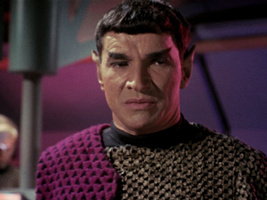
 Romulan Commander in TOS: "Balance of Terror"
Romulan Commander in TOS: "Balance of Terror"